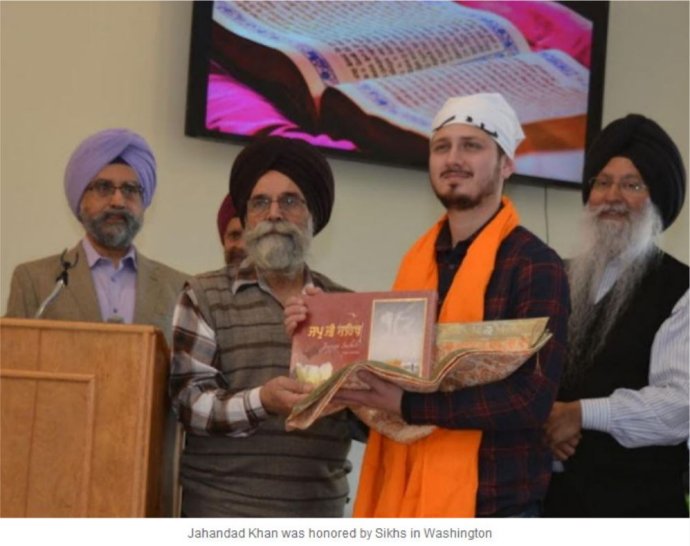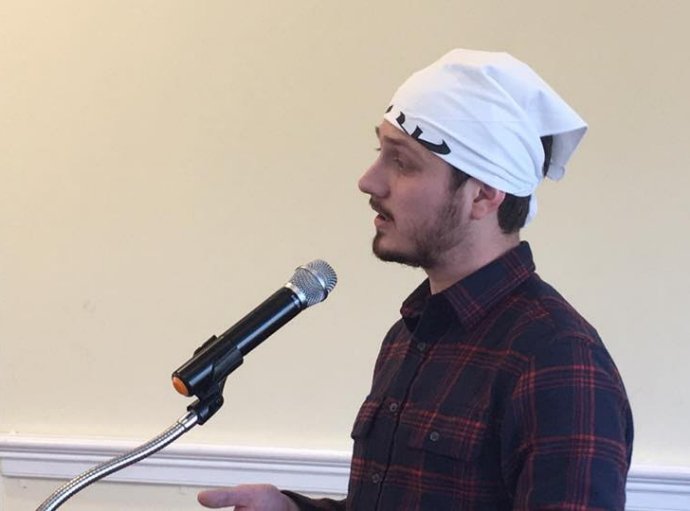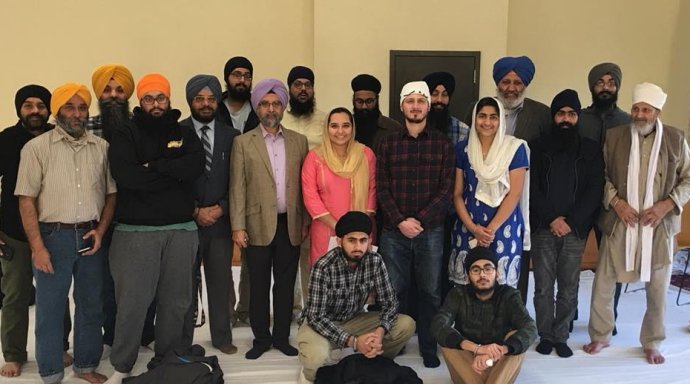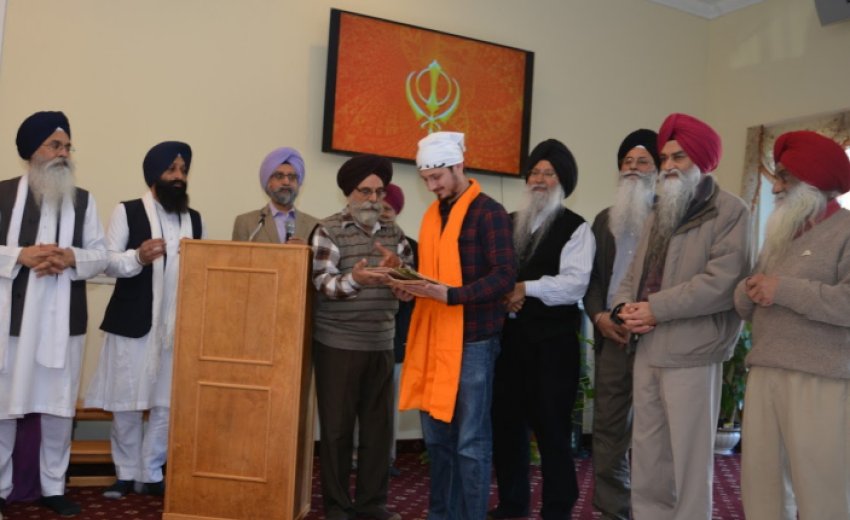Guru Gobind Singh Foundation
www.ggsfusa.org
World Needs to Learn Statesmanship from Sikh Legend Hari Singh Nalwa - Pakistani Sikh Researcher

Washington, January 16, 2018 - "The world has a great deal to learn from the Sikh legend Hari Singh Nalwa." These were the words spoken by young 26-year old researcher, Jahandad Khan, at Guru Gobind Singh Foundation. Jahandad Khan has studied marketing at the Islamabad University of Science and Technology. His native region is Hazara, a region in the North-Eastern part of the Khyber Pakhtunkhwa province of Pakistan. It is located east of the Indus River and it borders with Afghanistan. He spoke on the Sikh rule in Hazara region and his connection to Sikh heritage.
He said, “My parents used to tell us that our home was built by a Sikh who was the commander of a great Sikh army. That led me to study more about Nalwa. My journey has taken me on an overlapping quest to connect with my own identity, and I learned that my own roots connected me with great legends like Hari Singh Nalwa and Maharaja Ranjit Singh, along with other Sikh heritage.” In the early 1800s, Maharaja Ranjit Singh ruled over this region from Lahore, as it known as Lahore Darbar. Ranjit Singh chose the bravest, most capable, and most competent commander, Hari Singh Nalwa to subdue the most volatile region, as this region has always been the most unruly area to govern as it is now.
Jahandad Khan's ancestor and namesake Jahandad Khan was a contemporary of Hari Singh Nalwa - Khan’s father Painda Khan (mentioned in Umdat ut Tawarikh) had earlier fought with Nalwa but had to offer his son to the Lahore Darbar as a hostage in return for help against Ahmed Barelvi when he invaded this region. The young Jahandad Khan was raised by Nalwa for few years as a result of this settlement. When Sikh garrisons in Hazara were defeated by the British and they were being massacred in 1846, it was the same Jahandad Khan (by then a grown young man and a leader of the Tanoli clan) who spared the lives of all Lahore Darbar men stationed in this region in 22 mud forts and gave them a dignified exit (mentioned in Hazara Gazzetteers as well).
Dr. Rajwant Singh, Secretary of Guru Gobind Singh Foundation and Co-Founder of the National Sikh Campaign, said, “We are pleased to see Jahandad Khan’s passion for Hari Singh Nalwa and his drive to create better understanding among Sikhs and the people of Pakistan, especially in the Hazara region. We feel that his work needs to supported by all Sikhs and by major Sikh institutions. Hari Singh Nalwa is a great role model for the youth and his life needs to be presented in a creative manner. Nations, especially India and Pakistan, and the people in the South Asia can take clues from Nalwa's life to create a better environment in the entire region."

“The key point is that contemporary literature has reduced Hari Singh Nalwa as just being a great commander and a warrior whereas my research through various sources and narratives from the local population in the region has shown me that he was a great administrator, a skillful diplomat and I would not shy away from calling him a great statesman”, said Khan.
He added, “Nalwa was governor of Hazara for 15 years. Jahanded’s ancestor, Jahandad Khan I, had a complex relationship with Nalwa in which they were enemies at times and were allies at times. Nalwa spent lot of time interacting with the local population to develop relationships with locals and the tribal chiefs. He built a city, Haripur, named after him, which has now become a big city. The entire irrigation system was set up by Nalwa and he standardized the weight system for trade. He did not just rule the area but also wanted to make sure that the local population thrived economically.”
He stated, “Haripur, which was totally barren, now has these orchards and that was totally introduced by Nalwa. Harkishan Garh, a fort built by Nalwa, has the remnants of these orchards and comprehensive irrigation system that was also introduced by Nalwa. This is still the backbone of local agriculture. In addition, 22 mud forts were built by Nalwa and some of them need preservation.” He continued with, “Painda Khan, the most powerful chieftain, resisted Nalwa for years and Nalwa tried six times to have peace negotiations with Khan. It seems that our ancestors were far more pragmatic and practical than we are now. We have reduced them to ideological symbols, which is fine, but at the same time we need to study history with an open mind and read history from different sources.”
“Nalwa’s vision was to balance power with understanding the needs to the local population. Those are the lessons we all can learn from him, regardless of our religious backgrounds. We tend to look at history as binaries; that this is Sikh history, or this is Islamic history, whereas people like Nalwa cannot be boxed into one corner of our historical memory.”
He stated, “Sikh contact with the tribal region took place during Guru Nanak’s time. Elders narrate how Guru Nanak influenced the locals there and many local Muslim tribes converted to Sikhism. Last names of many Sikhs there represented their tribes.”
While shining light on the past Sikh rule, he added, “No other contact with foreign power, whether it was Abdali’s era, Mughal era or the colonial time, is seen by the locals as positively as they view Sikhs. The first political contact with our tribes was with Sikhs during the Ahmed Shah Abdali ‘s time. Sikh rule was the first experience of organized governance for this region. The tribal system was converted into social contract and tribalism to state craft. The Sikh period was not only Sikhs ruling; in fact, half of the army consisted of Muslims. There is a general impression that Sikhs are honest. Local women tell their children to buy things from Sikh shopkeepers as a Sikh shopkeeper would not sell anything impure or overpriced. This is the land where Sikhism started, however Sikh presence along the Indus has never been studied deeply.” He said, “There is a perception that Sikh heritage in Pakistan is crumbling because it is not Muslim, but in fact no heritage is being preserved the way it should be.”
My message to the youth would be to understand history rationally. If we read history with bias, it might give us a chance to give ourselves a pat on the back with a lot of pride or a lot of sense of superiority, but then it would reduce our capacity to learn and grow. We need to broaden the canvas of history and understand it from all perspectives.
I would also like to appeal to Sikhs, particularly to youth, to come to these places. There is no substitute to interaction with the local population. The Sikh community only goes to Panja sahib or Nankana Sahib, the two most popular sites related to Guru Nanak, however Pakistan has layers and layers of history related to Sikh history. There are so many battlefields, forts and infra-structure set up and built by the Sikhs. They were not only fighters, but they were also builders. They were artists and open-minded, as shown by Hinduism and Islam also being represented in frescoes.
Currently, people don’t try to understand each other and instead just pass judgments. That is the greatest lesson rulers of South Asia can learn from Nalwa. He chose to understand the area, the people, their customs and their likes and dislikes. What sort of person will be so nice to the son of his own enemy?"
Inder Paul Singh Gadh, Chairman of GGSF, said, “We are grateful to Jahandad Khan for traveling so far to connect with the Sikh youth in America, and he has inspired many in the congregation today.”

Khan held an hour long interactive session with the 35 young members of the community.

